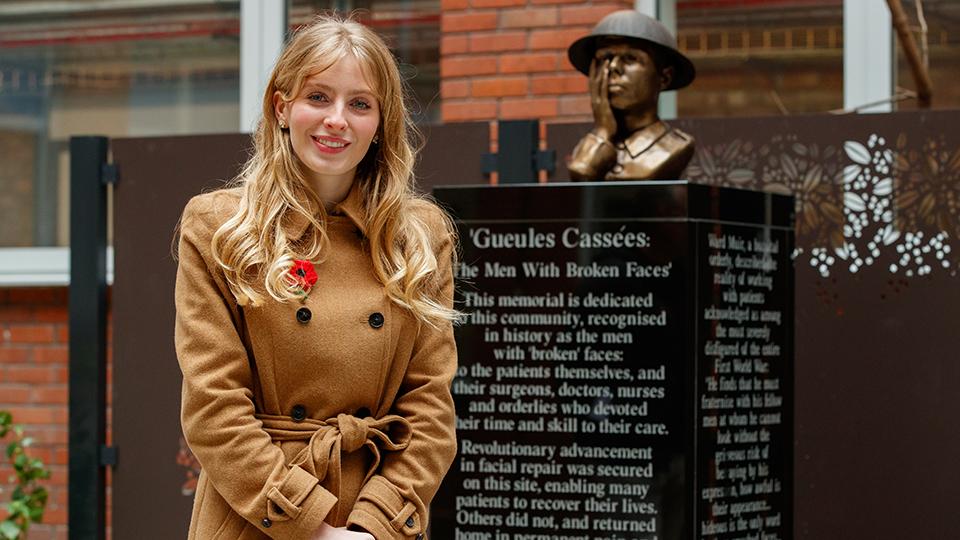Memorial to the forgotten faces of World War One
Primary page content
Men who were facially disfigured in the First World War are to get their own memorial thanks to a campaign by a graduate of Goldsmiths, University of London.

Ellie Grigsby with the finished memorial.
The memorial, featuring a bronze bust of a soldier wearing an original helmet donated by the Somme Museum, will be unveiled at Queen Mary's Hospital, Sidcup at an invitation-only event on 24 November 2019.
Ellie Grigsby was inspired to launch the campaign while studying the MA in History at Goldsmiths after finding that 12% of the Great War wounded suffered facial injuries and yet the plight of facially-disfigured men barely featured in museums or popular culture.
Queen Mary's Hospital was chosen as it was on this site at The Queen's Hospital that between 1917-1925 the early pioneers of plastic surgery carried out at least 11,000 operations attempting to give wounded men their faces back.
Ellie Grigsby said: “While many veterans were treated successfully, thanks to techniques pioneered at The Queen's Hospital, thousands more couldn't be 'fixed’. My research found a haunting absence of the stories of these men with ‘broken faces’ from the official accounts almost as if they were airbrushed out of history.
“I came across stories of mirrors being banned from hospital wards, children cowering from their fathers who came home from the front with a new face, and sweethearts who couldn’t bear to look at their lovers. Instead of a hero’s welcome, these men came back to pitying looks, glares, and people on the street peering into buggies to see if their ‘broken faces’ had been passed on to their babies.
“These men felt such overwhelming social pressure to hide their disfigurement behind facial prosthetics and tin masks that some were even buried still wearing them: they lost not just their faces but their identities. Despite all the books and exhibitions about World War One their suffering has been largely forgotten, so I had to do something to ensure they would be remembered.”
After beginning her MA studies in September 2016, Ellie launched the project in April 2017. She sketched her first design on greaseproof paper in her kitchen but soon realised turning this into a permanent memorial would cost in excess of £12,000. Initially she received support from family and friends but then set up a crowdfunding web page and began approaching local schools and charitable organisations to help raise funds for the project.
“People were incredibly generous,” Ellie said, “but it was still a struggle to find time around my MA studies to persuade people to support the project and to raise so much money. There were times when I wondered if it would ever happen so it’s exciting that it’s now become a reality and, fittingly, will be unveiled by relatives of some of those veterans treated for facial injuries at The Queen’s Hospital.”
Ellie worked with experts at the London Foundry to realise her design. The life-size bronze bust shows a soldier wearing a World War One helmet with one hand raised to his face. When mounted on its inscribed marble plinth, alongside a pair of bronze soldiers’ boots, the memorial will weigh-in at over 1.5 tonnes and stand over 6ft tall. It will be installed in the grounds of Queen Mary’s Hospital, Sidcup.
NOTE: All enquiries about this project should go to: communications@gold.ac.uk This article was updated to include photos from the unveiling event.
The story behind the forgotten faces project